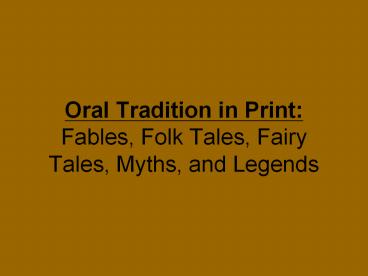Oral Tradition in Print: Fables, Folk Tales, Fairy Tales, Myths, and Legends - PowerPoint PPT Presentation
Title:
Oral Tradition in Print: Fables, Folk Tales, Fairy Tales, Myths, and Legends
Description:
Oral Tradition in Print: Fables, Folk Tales, Fairy Tales, Myths, and Legends Fables Definition: A brief story that sets forth some pointed statement of truth Origin ... – PowerPoint PPT presentation
Number of Views:303
Avg rating:3.0/5.0
Title: Oral Tradition in Print: Fables, Folk Tales, Fairy Tales, Myths, and Legends
1
Oral Tradition in PrintFables, Folk Tales,
Fairy Tales, Myths, and Legends
2
Fables
- Definition A brief story that sets forth some
pointed statement of truth - Origin Found in almost every country
- Handed down from generation to generation as oral
literature - Content Usually contains incidents that relate
to the unusual, sometimes supernatural - Contains
a moral or lesson - Characters often animals or plants given human
qualities, but people and supernatural figures
may appear - Structure lacks development of characters
- Examples Aesops fables, The Tortoise and the
Hare
3
Folk Tales / Tall Tale
- Definition deal with heroes, adventure, magic or
romance - Some are tall tales- stories that contain
hyperbole. (Ex Paul Bunyan) - Origin American folk literature
- Oral tradition (word of mouth) no known author
- Content Based on hard-working people
- Bragging and exaggeration HYPERBOLE (tall tale)
- Humorous or witty
- Seemingly impossible feats
- Characters people, fictional characters
- Told to make the narrator seems as if he/she was
part of the story - Examples Ali Baba, Johnny Appleseed, Jack the
Beanstalk
4
Fairy Tales
- Definition fictional story that may feature
folkloric characters and enchantments - Origin almost all cultures
- Oral tradition and then written and recorded
- Content Associated with children
- Characters fairies, goblins, elves, trolls,
giants, gnomes, talking animals, princes,
princesses, witches, wicked stepmothers, fairy
godmothers, etc. - Structure Contains elements of plot
- Examples Cinderella, Snow White, Sleeping
Beauty, etc.
5
Myths
- Definition a sacred narrative explaining how the
world and humankind came to be in their present
form - Origin Almost all cultures
- Passed through oral tradition
- Content Closely linked to religion and the
explaining of why something is establishes
models for behavior - Characters Gods or supernatural heroes
- Structure Elements of plot, personification
- Examples Greek mythology, Roman mythology
6
Legends
- Definition stories about the past. They are
often based on facts, but storytellers have added
imaginative details. - Origin found in almost all cultures
- Passed on through oral tradition
- Content occurrence of miracles
- Characters real people going through imaginary
events - Structure Includes element of plot
- Examples Beowulf, Robin Hood
- George Washington cutting down the cherry tree
7
Quiz Time w/ group
- Which genre teaches a moral at the end?
- Which genre usually features gods goddesses?
- Which genre usually has no known author is
passed down by word of mouth (oral tradition)? - Which genre includes elements of plot, is based
on facts, but has imaginative details? - Which genre has fictional characters, such as
fairies and giants?
8
COMMON ELEMENTS (p. 828)
- CLUES TO STORY DEVELOPMENT
- PLOT
- CHARACTER
- REPETITION/PATTERNS
- SETTING
- THEME
9
PLOT
- Sequence of events in a story that revolves
around a conflict, or problem. - In folk literature, events unfold quickly and
predictably (much easier than in novels or longer
stories) - Notice the way
- Events are presented in sequence
- Main character solves the conflict often w/ help
of gods or magic - Satisfying conclusion
10
(No Transcript)
11
REPETITION/PATTERNS
12
(No Transcript)
13
(No Transcript)































